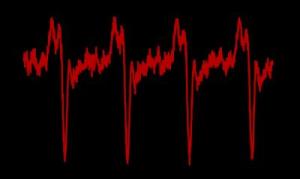In an advance that sounds almost Zen, researchers at the National Institute of Standards and Technology (NIST) and JILA, a joint institute of NIST and the University of Colorado at Boulder, have demonstrated a new type of pulsed laser that excels at not producing light. The new device generates sustained streams of "dark pulses"—repeated dips in light intensity—which is the opposite of the bright bursts in a typical pulsed laser.
Despite its ominous name, the dark pulse laser is envisioned as a tool for benign communications and measurements based on infrared light frequencies. The laser's ultrashort pulses span just 90 picoseconds (trillionths of a second), making the device suitable for measurements on short timescales. Dark pulses might be useful in signal processing because, unlike bright pulses, they generally propagate without distortion. Dark pulses might be used like a camera shutter for a continuous light beam in optical networks.
 Colorized trace of pulses from the NIST/JILA "dark pulse " laser, indicating the light output nearly shuts down about every 2.5 nanoseconds.
Colorized trace of pulses from the NIST/JILA "dark pulse " laser, indicating the light output nearly shuts down about every 2.5 nanoseconds.
Described in Optics Express, the new NIST/JILA technology is the first to generate dark pulses directly from a semiconductor laser cavity, without electrical or optical shaping of pulses after they are produced. The chip-sized infrared laser generates light from millions of quantum dots (qdots), nanostructured semiconductor materials grown at NIST. Quantum dot lasers are known for unusual behavior.
In the new NIST/JILA laser, small electrical currents are injected into the laser, causing the qdots to emit light. The qdots are all about the same size—about 10 nanometers (billionths of a meter) wide—and thus, because of a nanostructured design that makes them behave like individual atoms, all emit light at the same frequency. The current generates enough energy to amplify the emissions from the collective dots, creating the special properties of laser light.
The new laser depends on the qdots' unusual energy dynamics, which have the effect of stabilizing dark pulses. After emitting light, qdots recover energy from within rapidly (in about 1 picosecond) but more slowly (in about 200 picoseconds) from energy inputs originating outside the qdots in the laser cavity. This creates a progression of overall energy gains gradually giving way to overall energy losses. Eventually, the laser reaches a steady state of repeated brief intensity dips—a drop of about 70 percent—from the continuous light background.
The dark pulse laser was developed through close collaborations between NIST experts in qdot growth and semiconductor laser design and fabrication, and JILA experts in ultrafast lasers and related measurements. NIST has ongoing research efforts to develop quantum dot lasers and to develop modeling, fabrication, and measurement methods for semiconductor nanostructures such as quantum dots. In general, semiconductor lasers are being considered for many advanced applications, such as next-generation atomic clocks based on optical frequencies, for which large lasers are costly and complex.
Source: http://www.nist.gov/index.html